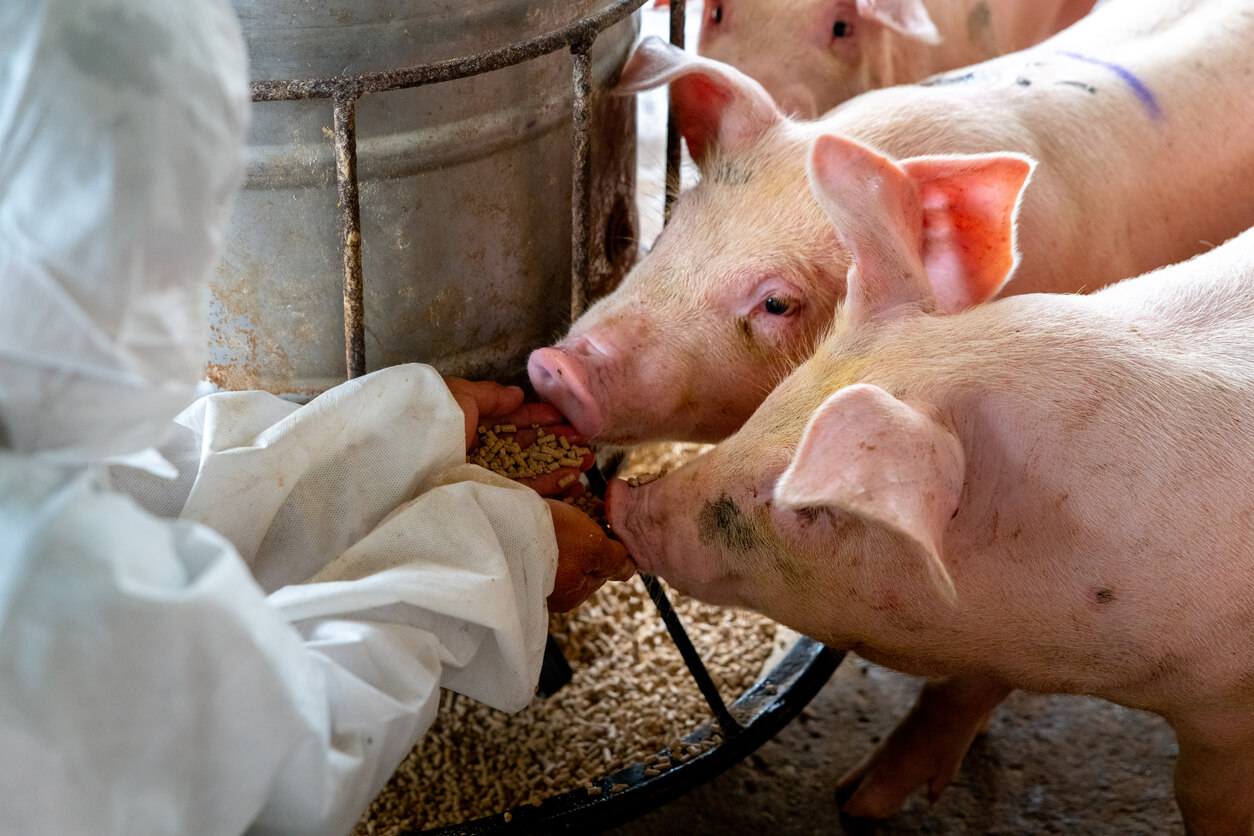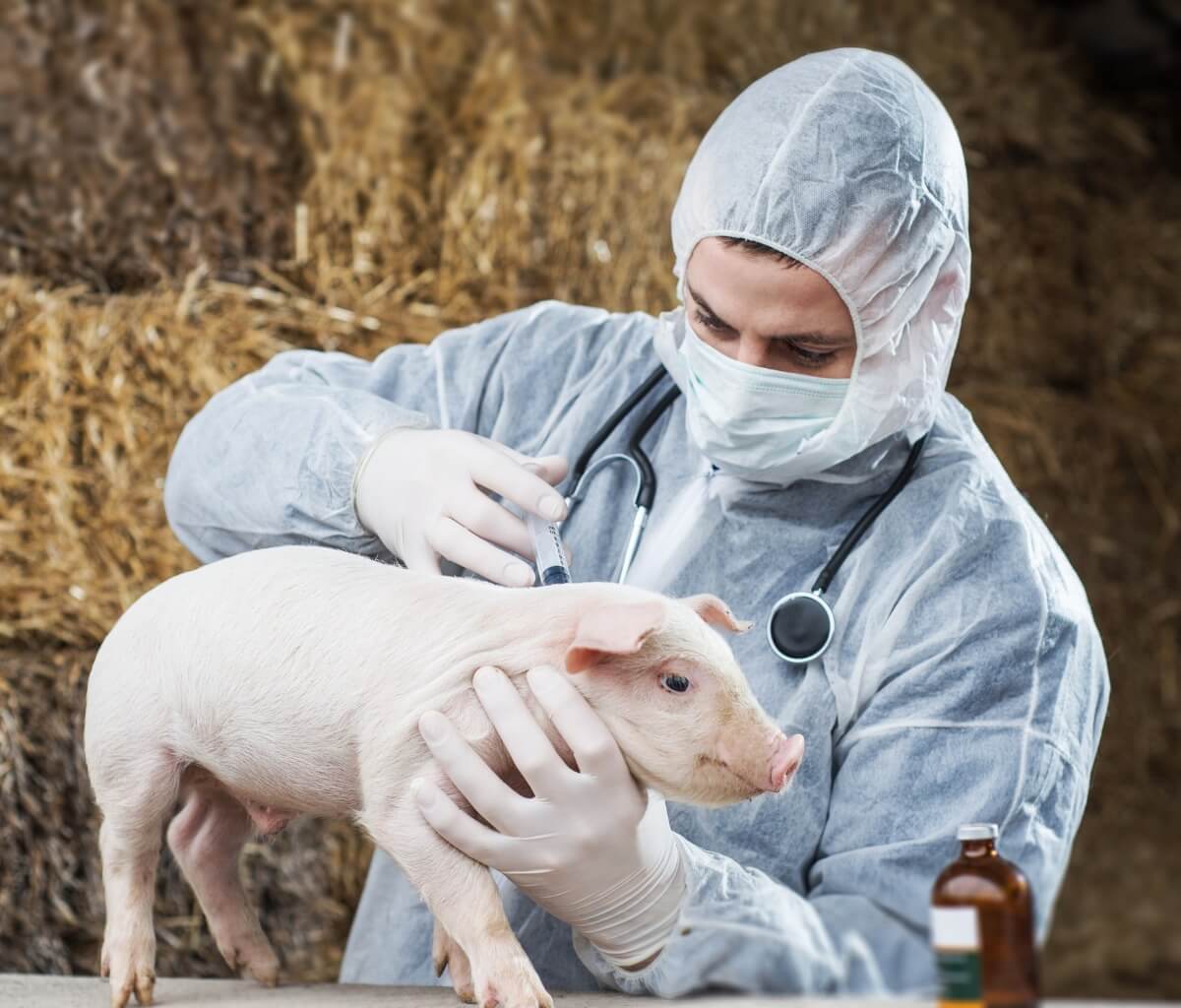Top 10 Most Common Diseases in Pigs


Written and verified by the biologist Samuel Sanchez
Pigs are universally used in the meat industry, but the existence of certain breeds (such as the mini pig) is increasingly establishing their validity as domestic pets. Both owners and farmers should be alert when detecting the 10 common diseases in pigs that we show you below.
Pigs are social animals, empathetic, intelligent, and with a lot of personality. Because of this, it’s easy to notice when something is wrong with them when their behavior changes. Here are the most common conditions in pigs and how to detect them before it’s too late.
1. Coccidiosis
As the name suggests, coccidiosis is caused by small parasites known as coccidia. These microorganisms multiply inside the cells of their host, especially those located in the digestive tract. The pathogens belong to the genera Eimeria, Isospora, and Cryptosporidia.
The oocysts (infective structures) are secreted by the diseased specimens. They’re resistant to many cleaning products and end up being accidentally ingested by previously healthy pigs. These pathogens cause diarrhea, dehydration, abnormally colored feces, and secondary infections.
In severely affected juveniles there’s a mortality rate of 20%.
2. Exudative dermatitis
Exudative dermatitis is a skin condition caused by the bacterium Staphylococcus hyicus, which invades scraped skin and causes infection. This is one of the most common diseases in newborn pigs, as carrier dams have a high pathogen load in the birth canal and infect their offspring as soon as they are born.
Piglets can become injured by competing for the mother’s teats during the first days of life, which provides an excellent window for the pathogen. As indicated by professional sources, the most severely infected lesions appear in suckling pigs and the mortality rate at this stage is high. On the other hand, in adults it can occur in a subacute and multifocal form.
The skin of affected pigs becomes dark due to excessive sebaceous secretion.

3. Swine dysentery
Swine dysentery is a serious disease caused by the bacterium Brachyspira hyodysenteriae. It’s a condition unique to pigs, but the etiological agent can also be detected in rodents. It causes mucohaemorrhagic diarrhea and inflammation limited to the intestinal environment.
The bacterium is accidentally ingested and symptoms take 5-21 days to appear. The microorganism affects the epithelium of the intestine, so the signs are similar to those of coccidiosis: diarrhea (in this case with blood), dehydration, weight loss, apathy, and depressed eye sockets.
If left untreated, this condition can reach a mortality rate of 50% or more.
4. Porcine parvovirus
Porcine parvovirus is a fairly resistant virus that multiplies in the pig intestine, but doesn’t usually cause clear clinical signs. It’s also noteworthy that it can remain outside the host for several months and is resistant to many types of disinfectants, so it’s a common pathogen to have to live with on farms.
The only real problem reported with this virus is the loss of reproductive efficiency in unvaccinated sows. It’s common to have small litters associated with a high rate of embryonic losses, mummified piglets of variable sizes, and increased numbers of dead piglets on the farm.
5. Mastitis, metritis, agalactia (MMA)
These three conditions, collectively known as MMA syndrome, represent some of the common diseases in breeding pigs, specifically in females. Mastitis refers to infection of the sow’s mammary glands, metritis refers to inflammation of the uterus, and agalactia refers to the lack of milk in the breasts during lactation.
The most obvious symptom of this disorder is the presence of swollen, compact, reddish, warm-to-the-touch breasts in the freshly farrowed sow. Piglets can also be severely affected by this event, as they’ll not be able to suckle normally and will eventually die from hypoglycemia (lack of sugars).
6. Leptospirosis
Leptospirosis is one of the most common diseases in pigs and is caused by the bacterium Leptospira interrogans. It usually causes kidney problems, but reproductive failures are also associated with this condition. It must be taken into account that it’s a zoonosis, that is, it can also affect humans.
It causes symptoms such as fever, poor appetite, depression, abortions in the third trimester (in sows), increased production of weak piglets, jaundice, hemorrhages, and, in the worst cases, sudden death. Some mammalian species (such as rats and hedgehogs) act as reservoirs for the pathogen, so they should be kept away from the pig facility at all costs.
7. Respiratory diseases
Respiratory diseases are common in pigs and the causative agent varies from case to case. Some of the most common are as follows:
- Pasteurella multocida pneumonia: These agents enter the nasal passages of the pig and cause atrophy of the turbinates. Then they go to the lungs and inflame bronchi and alveoli, causing acute pneumonia.
- Mycoplasma Hyopneumoniae pneumonia: The pathogen causes chronic respiratory disease and amplifies the symptomatology of other conditions, such as influenza and porcine respiratory syndrome.
- Atrophic rhinitis: In this pathology, the tissues of the nasal passages become inflamed and cause a clear predisposition to other diseases.
- Influenza: Influenza, or swine flu, is a respiratory disease of great seriousness due to its transmissibility and zoonotic potential. There are hardly any farms without positive cases, so it’s considered an endemic condition worldwide.
These respiratory diseases typically cause coughing, dyspnea (respiratory distress), sneezing, loss of growth, and an increased likelihood of death in affected pigs. Because the etiologies are similar, sometimes the diagnostic process is complicated.

In this space, we’ve brought you 10 common diseases in pigs: 6 in detail and 4 of a general respiratory type. All of them require immediate veterinary attention, as they’re highly contagious and can affect the whole group of swine in a few weeks.
Pigs are universally used in the meat industry, but the existence of certain breeds (such as the mini pig) is increasingly establishing their validity as domestic pets. Both owners and farmers should be alert when detecting the 10 common diseases in pigs that we show you below.
Pigs are social animals, empathetic, intelligent, and with a lot of personality. Because of this, it’s easy to notice when something is wrong with them when their behavior changes. Here are the most common conditions in pigs and how to detect them before it’s too late.
1. Coccidiosis
As the name suggests, coccidiosis is caused by small parasites known as coccidia. These microorganisms multiply inside the cells of their host, especially those located in the digestive tract. The pathogens belong to the genera Eimeria, Isospora, and Cryptosporidia.
The oocysts (infective structures) are secreted by the diseased specimens. They’re resistant to many cleaning products and end up being accidentally ingested by previously healthy pigs. These pathogens cause diarrhea, dehydration, abnormally colored feces, and secondary infections.
In severely affected juveniles there’s a mortality rate of 20%.
2. Exudative dermatitis
Exudative dermatitis is a skin condition caused by the bacterium Staphylococcus hyicus, which invades scraped skin and causes infection. This is one of the most common diseases in newborn pigs, as carrier dams have a high pathogen load in the birth canal and infect their offspring as soon as they are born.
Piglets can become injured by competing for the mother’s teats during the first days of life, which provides an excellent window for the pathogen. As indicated by professional sources, the most severely infected lesions appear in suckling pigs and the mortality rate at this stage is high. On the other hand, in adults it can occur in a subacute and multifocal form.
The skin of affected pigs becomes dark due to excessive sebaceous secretion.

3. Swine dysentery
Swine dysentery is a serious disease caused by the bacterium Brachyspira hyodysenteriae. It’s a condition unique to pigs, but the etiological agent can also be detected in rodents. It causes mucohaemorrhagic diarrhea and inflammation limited to the intestinal environment.
The bacterium is accidentally ingested and symptoms take 5-21 days to appear. The microorganism affects the epithelium of the intestine, so the signs are similar to those of coccidiosis: diarrhea (in this case with blood), dehydration, weight loss, apathy, and depressed eye sockets.
If left untreated, this condition can reach a mortality rate of 50% or more.
4. Porcine parvovirus
Porcine parvovirus is a fairly resistant virus that multiplies in the pig intestine, but doesn’t usually cause clear clinical signs. It’s also noteworthy that it can remain outside the host for several months and is resistant to many types of disinfectants, so it’s a common pathogen to have to live with on farms.
The only real problem reported with this virus is the loss of reproductive efficiency in unvaccinated sows. It’s common to have small litters associated with a high rate of embryonic losses, mummified piglets of variable sizes, and increased numbers of dead piglets on the farm.
5. Mastitis, metritis, agalactia (MMA)
These three conditions, collectively known as MMA syndrome, represent some of the common diseases in breeding pigs, specifically in females. Mastitis refers to infection of the sow’s mammary glands, metritis refers to inflammation of the uterus, and agalactia refers to the lack of milk in the breasts during lactation.
The most obvious symptom of this disorder is the presence of swollen, compact, reddish, warm-to-the-touch breasts in the freshly farrowed sow. Piglets can also be severely affected by this event, as they’ll not be able to suckle normally and will eventually die from hypoglycemia (lack of sugars).
6. Leptospirosis
Leptospirosis is one of the most common diseases in pigs and is caused by the bacterium Leptospira interrogans. It usually causes kidney problems, but reproductive failures are also associated with this condition. It must be taken into account that it’s a zoonosis, that is, it can also affect humans.
It causes symptoms such as fever, poor appetite, depression, abortions in the third trimester (in sows), increased production of weak piglets, jaundice, hemorrhages, and, in the worst cases, sudden death. Some mammalian species (such as rats and hedgehogs) act as reservoirs for the pathogen, so they should be kept away from the pig facility at all costs.
7. Respiratory diseases
Respiratory diseases are common in pigs and the causative agent varies from case to case. Some of the most common are as follows:
- Pasteurella multocida pneumonia: These agents enter the nasal passages of the pig and cause atrophy of the turbinates. Then they go to the lungs and inflame bronchi and alveoli, causing acute pneumonia.
- Mycoplasma Hyopneumoniae pneumonia: The pathogen causes chronic respiratory disease and amplifies the symptomatology of other conditions, such as influenza and porcine respiratory syndrome.
- Atrophic rhinitis: In this pathology, the tissues of the nasal passages become inflamed and cause a clear predisposition to other diseases.
- Influenza: Influenza, or swine flu, is a respiratory disease of great seriousness due to its transmissibility and zoonotic potential. There are hardly any farms without positive cases, so it’s considered an endemic condition worldwide.
These respiratory diseases typically cause coughing, dyspnea (respiratory distress), sneezing, loss of growth, and an increased likelihood of death in affected pigs. Because the etiologies are similar, sometimes the diagnostic process is complicated.

In this space, we’ve brought you 10 common diseases in pigs: 6 in detail and 4 of a general respiratory type. All of them require immediate veterinary attention, as they’re highly contagious and can affect the whole group of swine in a few weeks.
All cited sources were thoroughly reviewed by our team to ensure their quality, reliability, currency, and validity. The bibliography of this article was considered reliable and of academic or scientific accuracy.
- Epidermitis Exudativa Porcina, PDF. Recogido a 7 de octubre en https://www.3tres3.com/3tres3_common/tienda/doc/BLUSTARITbr.pdf
- Swine dysentery, Iowa State University. Recogido a 7 de octubre en https://vetmed.iastate.edu/vdpam/FSVD/swine/index-diseases/swine-dysentery
This text is provided for informational purposes only and does not replace consultation with a professional. If in doubt, consult your specialist.








